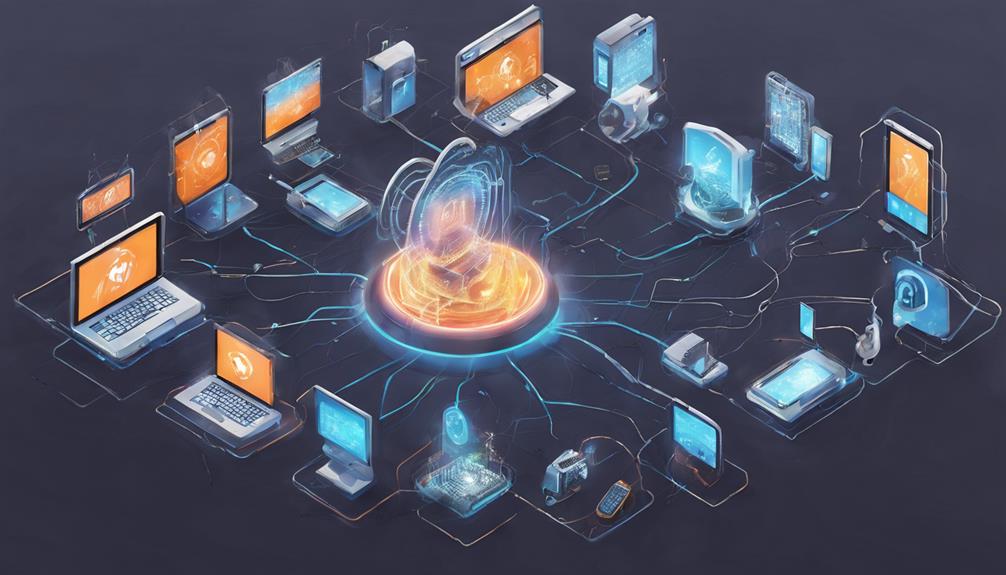5G's safety from hackers faces challenges such as network design susceptibility, rogue access points, and software vulnerabilities. Risks heighten with extensive deployment and interconnected devices, posing threats to data integrity and privacy. Encryption, firewalls, and robust security protocols fortify 5G networks against cyber threats. End-to-end encryption, strong authentication, and continuous monitoring bolster security. AI aids threat detection, and standardized frameworks are essential. Understanding security risks and implementing stringent measures are important for safeguarding 5G networks. A thorough exploration of security protocols and encryption fortification can enhance protection against potential vulnerabilities.
Key Takeaways
- Implementing robust encryption protocols fortifies 5G networks against hackers.
- Continuous monitoring and encryption protocols enhance 5G network security.
- Strong authentication methods and access controls protect 5G networks.
- AI enhances threat detection and response capabilities in 5G networks.
- Proactive identification and mitigation of vulnerabilities are crucial for safeguarding 5G networks.
Potential 5G Security Risks
The potential security risks associated with 5G networks stem from their susceptibility to a range of cyber threats due to the network's design and infrastructure. One significant concern revolves around the presence of potential rogue access points within 5G networks. These access points could be exploited by malicious actors to intercept sensitive data, posing a serious threat to the network's security integrity.
Moreover, the software-based nature of 5G networks creates additional vulnerabilities that hackers can exploit. By leveraging the inherent characteristics of software-defined networking, hackers may gain access to tools and technologies that aid them in launching sophisticated attacks on the network.
The widespread deployment of 5G technology also introduces a multitude of access points, thereby increasing the network's overall vulnerability to cyber attacks. This extensive network of connected devices not only expands the attack surface but also provides hackers with various entry points to target, amplifying the potential security risks associated with 5G networks.
Attack Surfaces and Vulnerabilities

Moreover, increased network capacity in 5G networks greatly expands the attack surfaces available to hackers, heightening the potential for exploiting vulnerabilities. With the significant increase in the number of connected devices and the larger bandwidth in 5G networks, there are more entry points for cyber attackers to target.
Vulnerabilities in network functions, especially in IoT devices that often transmit unencrypted data, create a prime target for potential cyber threats. Additionally, the presence of legacy network connections and GPRS tunneling protocols in 5G networks can introduce security weaknesses that malicious actors can exploit to gain unauthorized access to sensitive information.
In addition, the adoption of network function virtualization in 5G networks, while offering flexibility and efficiency, also brings about security risks if not adequately secured. This could potentially result in severe consequences such as data breaches and network disruptions.
Moreover, weaknesses in IMSI encryption in 5G networks increase the susceptibility to spoofing attacks, where hackers could intercept and manipulate critical data flows, compromising the integrity and confidentiality of communications.
Encryption Protocol Weaknesses

The examination of encryption vulnerabilities in 5G networks is essential for evaluating the security protocols in place.
Understanding potential weaknesses in encryption can help identify areas where cybercriminals might exploit the system.
Encryption Vulnerabilities Analysis
Encryption protocol weaknesses in 5G networks pose a substantial threat to data security and privacy. The presence of encryption vulnerabilities in 5G opens the door for hackers to exploit these weaknesses, potentially leading to the interception and decryption of sensitive information transmitted over the network.
Hackers can take advantage of these vulnerabilities to bypass data protection mechanisms, gaining unauthorized access to 5G network traffic. This exploitation of encryption weaknesses not only allows for eavesdropping on communications but also jeopardizes data integrity.
Enhancing the security of 5G networks and protecting sensitive information from cyber threats necessitates addressing these encryption vulnerabilities promptly. By shoring up these weaknesses in encryption protocols, the overall security posture of 5G networks can be significantly fortified, ensuring that data remains confidential and secure from malicious actors seeking to compromise network integrity.
Security Protocol Evaluation
Security protocol evaluation plays an essential role in identifying and mitigating weaknesses within encryption protocols utilized in 5G networks. Encryption protocols in 5G networks are susceptible to exploitation by hackers, potentially allowing them to intercept and manipulate data, breaching network security.
Security researchers have flagged vulnerabilities in these encryption protocols, underscoring the importance of fortifying them to safeguard against hacker attacks. Ensuring the robustness of encryption protocols is crucial in protecting 5G networks from potential security breaches.
By scrutinizing and evaluating the security protocols in place, weaknesses can be uncovered and addressed proactively, enhancing the overall resilience of the network infrastructure. The continuous evaluation of encryption protocols is essential to stay ahead of evolving hacker tactics and maintain the integrity and confidentiality of data transmitted over 5G networks.
Strengthening security measures through protocol evaluation is imperative in the ongoing battle against cyber threats targeting 5G networks.
Network Slicing Vulnerabilities

Network slicing vulnerabilities in 5G pose significant risks, especially concerning data isolation and security per slice. These vulnerabilities could enable hackers to breach virtual networks, potentially leading to unauthorized access to sensitive information or disrupting critical services.
Implementing robust security measures, such as encryption and isolation protocols for each network slice, is essential to mitigate these risks and safeguard the integrity of 5G networks.
Data Isolation Risks
Data isolation risks in 5G due to network slicing are a significant challenge for protecting sensitive data. Network slicing allows multiple virtual networks to run on a shared physical infrastructure, increasing the vulnerability to data breaches. Hackers can exploit weaknesses in network slicing to access confidential information from one network while compromising others. Despite isolation mechanisms, there is a risk of unauthorized data access in these complex virtual networks.
To address these risks, strict security measures and proper protocol implementation are crucial. Inadequate security in network slicing configurations can expose critical data to breaches, highlighting the need for robust cybersecurity practices in 5G networks. It is essential to ensure secure isolation of each virtual network to maintain the integrity and confidentiality of sensitive information in the evolving 5G landscape.
Security per Slice
The segmentation of services within individual slices in 5G networks introduces inherent vulnerabilities that can be exploited by malicious actors. Network slicing, while offering flexibility and customization for various services, also creates security vulnerabilities.
Hackers can potentially exploit weaknesses in network slicing to gain unauthorized access to specific slices, compromising sensitive data and breaching confidentiality. To mitigate these risks, robust security measures need to be implemented to prevent cross-slice attacks. These attacks could lead to severe consequences such as service disruptions, data breaches, and the exploitation of critical infrastructure.
Ensuring the security per slice is essential in maintaining the integrity of 5G networks. Implementing proper security protocols and encryption techniques is vital to safeguard against potential hacking attempts targeting network slicing vulnerabilities. By addressing these security concerns, network operators can enhance the overall resilience and protection of 5G networks against sophisticated cyber threats.
Data Segregation Challenges

Effective segregation of information poses significant challenges in 5G networks due to the sheer volume of connected devices and the intricacies of network slicing. Data segregation is essential in safeguarding sensitive information and applications from unauthorized access and cyber threats.
The complexity of network slicing, which allows multiple virtual networks to run on a single physical infrastructure, adds a layer of difficulty to maintaining secure data segregation.
Proper data segregation is crucial to prevent data leaks, breaches, and unauthorized access within 5G networks. Without adequate measures in place, hackers could exploit vulnerabilities to gain access to critical data, leading to severe consequences.
To enhance security and protect against cyber threats, implementing robust data segregation protocols and network segmentation strategies is imperative. By ensuring strict data isolation and access control mechanisms, organizations can mitigate the risks associated with unauthorized data access and manipulation in the dynamic landscape of 5G networks.
Implementing Security Measures

Securing 5G networks requires the implementation of robust security measures to protect against unauthorized access and data breaches. Implementing encryption, firewalls, and security protocols are essential components in fortifying the integrity of 5G networks.
End-to-end encryption plays a vital role in enhancing data protection, making it challenging for hackers to intercept sensitive information. Strong authentication and authorization protocols add an additional layer of security, ensuring that only authorized individuals can access network resources.
Furthermore, the security features embedded within 5G networks are designed to combat potential cyber-attacks and vulnerabilities, safeguarding the system from breaches.
In the domain of the Internet of Things (IoT), 5G technology offers enhanced security measures to protect connected devices from hacking and unauthorized access. By securing access points and implementing stringent security mechanisms, IoT devices within a 5G network can operate safely and securely, reducing the risk of potential breaches.
As the digital landscape evolves, prioritizing security measures remains essential in ensuring the safety and integrity of 5G networks and the devices connected to them.
Safeguarding Against Unauthorized Access

Implementing strict access controls and encryption protocols is essential in safeguarding 5G networks against unauthorized access by hackers. By incorporating unique security measures such as end-to-end encryption and robust authentication mechanisms, 5G technology fortifies itself against potential cyber threats.
These security features create a formidable defense, reducing the susceptibility of 5G networks to unauthorized entry points exploited by malicious actors. Additionally, the integration of firewalls and access controls serves as a barrier, thwarting attempts of unauthorized access by hackers seeking to compromise the network's integrity.
Furthermore, the emphasis on cyber security in 5G networks plays a pivotal role in safeguarding against various forms of attacks, including Distributed Denial of Service (DDoS) attempts. With these measures in place, the risks associated with rogue access points and data interception by hackers are significantly lessened, ensuring a higher level of protection for the network infrastructure.
Ensuring Network Protection

Improving the resilience of 5G networks against cyber threats requires a holistic approach to network protection. As technology becomes more sophisticated, new security challenges arise, making it important to implement robust measures to safeguard networks. One effective strategy is the continuous monitoring of network activities to detect any anomalies that may indicate a potential breach. Additionally, the implementation of encryption and strong authentication protocols can greatly enhance the security of 5G networks.
To emphasize the importance of network protection, let's look at a comparison in the table below:
| Security Measure | Effectiveness | Importance | Implementation |
|---|---|---|---|
| Continuous Monitoring | High | Critical | Challenging |
| Encryption Protocols | Very High | Essential | Complex |
| Authentication Methods | High | Essential | Resource-intensive |
Mitigating Cyber Threats

Mitigating cyber threats in 5G networks requires a proactive approach to identifying and addressing vulnerabilities that could be exploited by malicious actors. The fifth generation networks present an expanded attack surface, especially with the proliferation of Internet of Things (IoT) devices, making it essential to implement robust security measures.
Hackers often target weaknesses in 5G networks, such as outdated network connections and unencrypted traffic, emphasizing the need for encryption and network slicing to enhance security. Artificial intelligence (AI) plays a pivotal role in bolstering threat detection and response capabilities within 5G networks, enabling swift action against potential breaches.
To effectively safeguard against evolving cyber threats, continuous training for cybersecurity professionals and the adoption of standardized security frameworks are imperative. By staying vigilant, utilizing advanced technologies like AI, and adhering to best practices, the integrity and security of 5G networks can be maintained in the face of persistent cyber risks.
Frequently Asked Questions
Is 5G a Security Risk?
5G networks present security risks stemming from their expanded attack surface and vulnerabilities in IoT devices. Exploitable weaknesses in 5G protocols and encryption can expose networks to various threats, necessitating robust security measures for protection.
Can My 5G Get Hacked?
A robust cybersecurity strategy is essential to safeguard 5G networks from potential hacking threats. Implementing strong encryption, authentication protocols, and continuous monitoring can help mitigate risks and protect against unauthorized access to 5G infrastructure and connected devices.
Is 5G Safer Than Wifi?
In comparison to Wi-Fi, 5G networks offer advanced security features, including end-to-end encryption, strong authentication protocols, and enhanced protection for IoT devices. These measures make 5G a safer option for data transmission and reduce vulnerability to hacking.
What's the Downside of 5g?
The downside of 5G lies in its susceptibility to a range of cyber threats, such as DDoS attacks, data interception via rogue access points, and the increased potential for network vulnerabilities due to the vast array of connected devices.
Conclusion
In summary, while 5G technology offers many benefits, it also presents potential security risks that must be addressed.
By implementing robust security measures, safeguarding against unauthorized access, ensuring network protection, and mitigating cyber threats, it is possible to minimize the risk of data breaches and attacks.
As the saying goes, 'an ounce of prevention is worth a pound of cure,' so it is important to prioritize security in the deployment of 5G networks.









